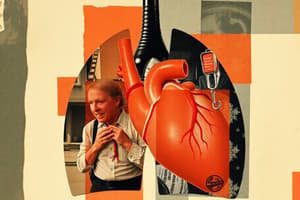Podcast
Questions and Answers
What happens to alveolar capillary walls when blood volume inside increases?
What happens to alveolar capillary walls when blood volume inside increases?
- They shrink
- They compress
- They distend (correct)
- They become more rigid
At high lung volumes, what happens to extra-alveolar vessel resistance to blood flow?
At high lung volumes, what happens to extra-alveolar vessel resistance to blood flow?
- It remains the same
- It increases
- It becomes irregular
- It decreases (correct)
What is the effect of increased cardiac output on pulmonary vascular resistance?
What is the effect of increased cardiac output on pulmonary vascular resistance?
- It decreases pulmonary vascular resistance (correct)
- It has no effect on pulmonary vascular resistance
- It increases pulmonary vascular resistance
- It makes pulmonary vessels more rigid
What is the primary cause of decreased resistance to pulmonary blood flow during exercise?
What is the primary cause of decreased resistance to pulmonary blood flow during exercise?
What is the main factor contributing to a decrease in pulmonary vascular resistance when pulmonary capillary blood volume increases?
What is the main factor contributing to a decrease in pulmonary vascular resistance when pulmonary capillary blood volume increases?
At what lung volume is pulmonary vascular resistance usually lowest?
At what lung volume is pulmonary vascular resistance usually lowest?
What is the main reason why edema fluid accumulates in the interstitium before the alveoli?
What is the main reason why edema fluid accumulates in the interstitium before the alveoli?
How does the resistance of pulmonary vessels compare to systemic circulation?
How does the resistance of pulmonary vessels compare to systemic circulation?
Which vessels of pulmonary circulation are analogous to the vessels where 70% of resistance in systemic circulation is found?
Which vessels of pulmonary circulation are analogous to the vessels where 70% of resistance in systemic circulation is found?
How do pulmonary vessels compare to systemic vessels in terms of compliance?
How do pulmonary vessels compare to systemic vessels in terms of compliance?
How many pulmonary veins normally enter the left atrium?
How many pulmonary veins normally enter the left atrium?
What type of vessels are considered exchange vessels in the pulmonary circulation?
What type of vessels are considered exchange vessels in the pulmonary circulation?
In which zone of the lung does continuous blood flow normally occur?
In which zone of the lung does continuous blood flow normally occur?
What is the characteristic of Zone 1 of the lung?
What is the characteristic of Zone 1 of the lung?
How is pulmonary capillary wedge pressure (PCWP) estimated?
How is pulmonary capillary wedge pressure (PCWP) estimated?
In which lung zone would capillary pressure never exceed alveolar pressure?
In which lung zone would capillary pressure never exceed alveolar pressure?
What is the function of the Swan-Ganz catheter in measuring PCWP?
What is the function of the Swan-Ganz catheter in measuring PCWP?
How does positive pressure ventilation (PPV) affect pulmonary blood flow?
How does positive pressure ventilation (PPV) affect pulmonary blood flow?
What effect does intrathoracic pressure have on venous return during mechanical ventilation?
What effect does intrathoracic pressure have on venous return during mechanical ventilation?
What happens to alveolar pressure during inspiration in positive pressure ventilation (PPV)?
What happens to alveolar pressure during inspiration in positive pressure ventilation (PPV)?
How does positive alveolar pressure during mechanical ventilation affect Zone 1?
How does positive alveolar pressure during mechanical ventilation affect Zone 1?
What role does positive end-expiratory pressure (PEEP) play in intrapulmonary shunting during ventilation?
What role does positive end-expiratory pressure (PEEP) play in intrapulmonary shunting during ventilation?
How does positive pressure ventilation affect total thoracic blood volume?
How does positive pressure ventilation affect total thoracic blood volume?
Which of the following situations would be expected to lead to an increase in the amount of the lung under zone 1 conditions?
Which of the following situations would be expected to lead to an increase in the amount of the lung under zone 1 conditions?
Which of the following situations would be expected to decrease pulmonary vascular resistance?
Which of the following situations would be expected to decrease pulmonary vascular resistance?
What might be expected to contribute to the formation of pulmonary edema?
What might be expected to contribute to the formation of pulmonary edema?
What causes active vasoconstriction in pulmonary circulation according to the text?
What causes active vasoconstriction in pulmonary circulation according to the text?
Flashcards are hidden until you start studying




